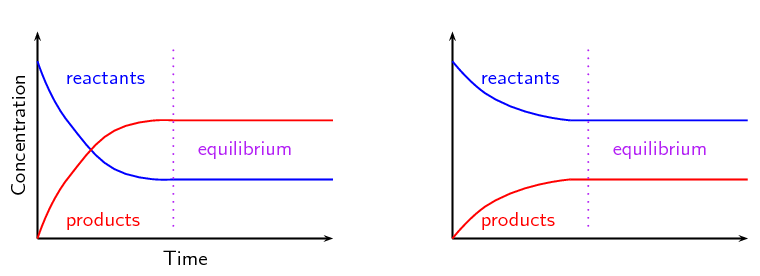Class 10 Exam > Class 10 Notes > Chemistry for GCSE/IGCSE > Equilibrium
Equilibrium | Chemistry for GCSE/IGCSE - Class 10 PDF Download
The Concept of Equilibrium
- We have already learned that a reversible reaction can occur in both directions.
- When the rates of the forward and reverse reactions become equal during a reaction, the entire reaction reaches a state of equilibrium.
- Equilibrium is a dynamic process where molecules on the left and right sides of the equation continually transform into each other through chemical reactions at an equal pace.
- The concentrations of reactants and products remain stable as long as there are no changes in factors like temperature and pressure.
- Equilibrium is only achievable in a closed system, preventing any of the chemical components from exiting the reaction vessel.

- An example of dynamic equilibrium is the reaction between hydrogen (H2) and nitrogen (N2) in the Haber process.
- Initially, with only nitrogen and hydrogen present, the forward reaction rate is highest due to their concentrations being at peak levels.
- As the reaction progresses, the concentrations of hydrogen and nitrogen decrease, leading to a decline in the forward reaction rate.
- Simultaneously, the concentration of ammonia increases, causing the backward reaction rate to rise (ammonia decomposes to reform hydrogen and nitrogen).
- Due to the interconnected nature of these reactions and the enclosed system, the forward and backward reaction rates eventually equalize, reaching equilibrium:
3H2 (g) + N2 (g) ↔ 2NH3 (g)
- The equilibrium position indicates the balance between reactant and product concentrations in the equilibrium state.
- Shifting the equilibrium to the left signifies an increase in reactant concentration.
- Conversely, a shift to the right indicates an increase in product concentration.
Question for EquilibriumTry yourself: What is the concept of equilibrium in a reversible reaction?View Solution
Le Chatelier's Principle
- The distribution of reactants and products at equilibrium varies based on reaction conditions, a concept elucidated by Le Chatelier's Principle, named after 19th-century French military engineer Henri Le Chatelier.
- This principle posits that a system at equilibrium adjusts in response to any changes in its conditions, opposing the change.
- Le Chatelier's Principle is applied to predict shifts in equilibrium position due to alterations in temperature, pressure, or concentration.
- Utilizing knowledge of energy changes, states, and concentrations, the principle enables manipulation of outcomes in reversible reactions.
- For instance, an increase in pressure prompts equilibrium to shift toward the side with fewer gaseous molecules.
- Equilibrium is deemed to shift rightward when the forward reaction is favored, resulting in increased product formation.
- Conversely, equilibrium shifts leftward when the reverse reaction is favored, leading to increased reactant formation.
Effects of Temperature on Equilibrium
Table showing the Effects of Temperature on Equilibrium

- Iodine monochloride reacts reversibly with chlorine to form iodine trichloride

- When the equilibrium mixture is heated, it becomes dark brown, indicating a shift towards endothermic reaction.
- The dark brown color signifies more ICl3 is produced, suggesting an endothermic backward reaction.
- Increasing temperature favors the endothermic direction of the equilibrium.
Effects of Pressure on Equilibrium
Table showing the Effects of Pressure on Equilibrium
- With an increase in pressure, the equilibrium position of the reaction between nitrogen dioxide and dinitrogen tetroxide shifts.

- Since there are two gas molecules on the left side and only one on the right, the shift occurs toward the direction with fewer gas molecules.
- Consequently, the equilibrium moves to the right, favoring the production of dinitrogen tetroxide.
- As a result, the reaction mixture becomes lighter in color as more colorless N2O4 is generated.
Effects of Concentration on Equilibrium
Table showing the Effects of Concentration on Equilibrium

- Elevating the concentration of either ICl or Cl2 leads to a shift in equilibrium toward the right.
- This shift favors the formation of the yellow product, ICl3.
- Conversely, a decrease in the concentration of ICl or Cl2 results in equilibrium shifting to the left.
- This favors the production of the dark brown reactant, ICl.
Effect of Catalyst on Equilibrium
- The presence of a catalyst doesn't change the equilibrium position but speeds up the rate of reaching equilibrium.
- This acceleration occurs because the catalyst lowers the activation energy for both forward and reverse reactions.
- Consequently, the concentrations of reactants and products remain the same at equilibrium as they would be without the catalyst.
Diagram showing the effect of a catalyst on the time taken for equilibrium to be established

Question for EquilibriumTry yourself: What happens to the equilibrium position when the concentration of reactants is increased in a reversible reaction?View Solution
The document Equilibrium | Chemistry for GCSE/IGCSE - Class 10 is a part of the Class 10 Course Chemistry for GCSE/IGCSE.
All you need of Class 10 at this link: Class 10
|
71 videos|157 docs|61 tests
|
Related Searches




















